Related Research Articles

Shropshire is a ceremonial county in the West Midlands of England, on the Welsh border. It is bordered by Wrexham County Borough and Cheshire to the north, Staffordshire to the east, Worcestershire to the south-east, Herefordshire to the south and Powys to the west. The largest settlement is Telford, and Shrewsbury is the county town.

Market Drayton is a market town and civil parish on the banks of the River Tern in Shropshire, England. It is close to the Cheshire and Staffordshire borders. It is located between the towns of Whitchurch, Wem, Nantwich, Newcastle-under-Lyme, Newport and the city of Stoke on Trent. The town is on the Shropshire Union Canal and bypassed by the A53 road.
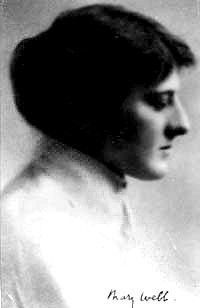
Mary Gladys Webb was an English romance novelist and poet of the early 20th century, whose work is set chiefly in the Shropshire countryside and among Shropshire characters and people whom she knew. Her novels have been successfully dramatized, most notably the film Gone to Earth in 1950 by Michael Powell and Emeric Pressburger based on the novel of the same title. The novels are thought to have inspired the famous parody Cold Comfort Farm (1932) by Stella Gibbons.
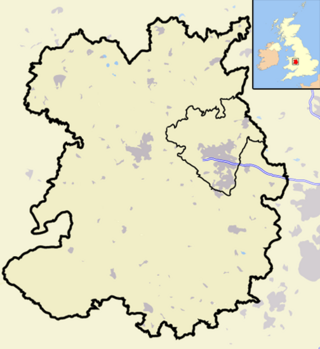
The Shropshire Wildlife Trust (SWT) is a wildlife trust covering the geographic county of Shropshire, England.

Shrewsbury Castle is a red sandstone castle in Shrewsbury, Shropshire, England. It stands on a hill in the neck of the meander of the River Severn on which the town originally developed. The castle, directly above Shrewsbury railway station, is a Grade I listed building.

The Stiperstones is a distinctive hill in Shropshire, England. The quartzite rock of the ridge formed some 480 million years ago. During the last Ice Age Stiperstones lay on the eastern margin of the Welsh ice sheet. The hill itself was not glaciated though glaciers occupied surrounding valleys and it was subject to intense freezing and thawing which shattered the quartzite into a mass of jumbled scree surrounding several residual rocky tors. At 536 metres (1,759 ft) above sea level it is the second-highest hill in the county, surpassed only by Brown Clee Hill. Stiperstones' 8-kilometre (5 mi) summit ridge is crowned by several jagged outcrops of rock, which may be seen silhouetted against the sky.

Pontesbury is a village and civil parish in Shropshire, and is approximately eight miles southwest of Shrewsbury. In the 2011 census, the village had a population of 1,873 and the parish had a population of 3,227. The village of Minsterley is just over a mile further southwest. The A488 road runs through the village, on its way from Shrewsbury to Bishop's Castle. The Rea Brook flows close by to the north with the village itself nestling on the northern edge of the Shropshire Hills AONB. Shropshire Council in their 2015 Place Plan detail the development strategy and refer to Pontesbury and neighbouring Minsterley as towns.
Shropshire was established during the division of Saxon Mercia into shires in the 10th century. It is first mentioned in 1006. After the Norman Conquest it experienced significant development, following the granting of the principal estates of the county to eminent Normans, such as Roger De Montgomery and his son Robert de Bellême.
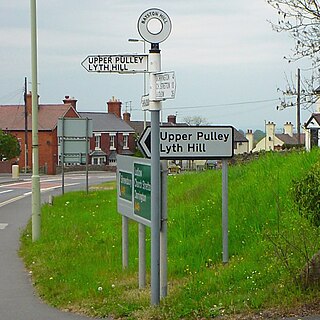
Bayston Hill is a village and civil parish in Shropshire, England. It is 3 miles (5 km) south of the county town Shrewsbury and located on the main A49 road, the Shrewsbury to Hereford road.

Condover is a village and civil parish in Shropshire, England. It is about 5 miles (8 km) south of the county town of Shrewsbury, and just east of the A49. The Cound Brook flows through the village on its way from the Stretton Hills to a confluence with the River Severn. Condover is near to the villages of Dorrington, Bayston Hill and Berrington. The population of the Condover parish was estimated as 1,972 for 2008, of which an estimated 659 live in the village of Condover itself. The actual population measured at the 2011 census had fallen to 1,957.
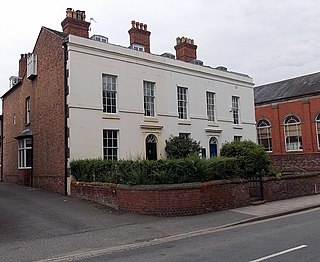
Coton Hill is an historic suburb of the town of Shrewsbury, Shropshire, situated in the ancient parish of St Mary. The River Severn flows nearby to the west, whilst Bagley Brook, the original river bed of the Severn runs to the east.

Meole Brace, sometimes known locally as simply MeoleMEE-əl, is a south-western suburb of Shrewsbury, Shropshire, England.

Cound is a village and civil parish on the west bank of the River Severn in the English county of Shropshire, about 7 miles south east of the county town Shrewsbury. Once a busy and industrious river port Cound has now reverted to a quiet rural community and dormitory village, for commuters to the commercial centres of Shrewsbury and Telford.

The Shrewsbury rail accident occurred on 15 October 1907. An overnight sleeping-car and mail train from Manchester to the West of England derailed on the sharply curved approach to Shrewsbury station, killing 18 people and injuring 33. The accident was concluded to be due to excessive speed on a dangerous curve.
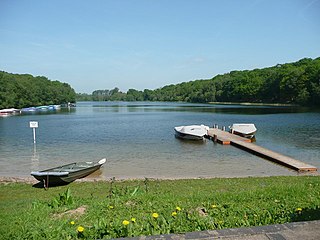
Bomere Pool is a large mere lying between the villages of Bayston Hill and Condover in the county of Shropshire, England, 4.7 miles south of the county town of Shrewsbury. The pool is classified as a Site of Special Scientific Interest as the most oligotrophic body of water on the Shropshire - Cheshire plain.

Shrewsbury is a market town, civil parish and the county town of Shropshire, England, on the River Severn, 150 miles (240 km) north-west of London. At the 2021 census, the parish had a population of 76,782.
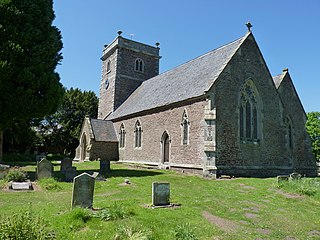
Church Pulverbatch is a small village and civil parish in central Shropshire, England. The population of the parish was 344 at the time of the 2001 census, increasing to 361 at the 2011 Census.
Colemere Countryside Site is a countryside heritage site. Due to its important conservation status it has two key designations being a Site of Special Scientific Interest (SSSI) and an internationally important Ramsar wetland site. 3 miles (4.8 km) south-east of Ellesmere, Shropshire.
Corbet Wood Countryside Heritage Site and Grinshill Site is a mixture of a woodland and quarrying site in Shropshire. It has been designated a SSSI due to the importance of geology in this area.
Rea Brook Valley is a country park, and Local Nature Reserve located in the town of Shrewsbury in Shropshire and is recognised nationwide as an important site for wildlife. This park is also known for its history in the Severn Valley Railway line. The Rea Brook is the watercourse that flows through the park.
References
- 1 2 3 "Lyth Hill countryside site". Shropshire Council. Archived from the original on 17 October 2013. Retrieved 17 October 2013.
- ↑ "This Week's Pictures from the Past". Shropshire Star. 14 November 2008. Retrieved 17 October 2013.
- ↑ "Shropshire general and churchman dies at 86". Shropshire Star. 5 November 1977. p. 6.
- ↑ From Redhill to Longden Common, Reflections of a Parish., published by Longden 2000 Group (2000), p.152. Lyth Hill was in the territory covered by the book.
- ↑ "Mary Webb, Writer in a Timeless Landscape". BBC Shropshire. 30 July 2008. Retrieved 17 October 2013.
- ↑ Hannaford, H. R. (October 2005). "An Archaeological Survey of Lyth Hill Countryside Site, Shrewsbury, Shropshire". Archaeology Service, Shropshire County Council. p. 3. Retrieved 17 October 2013.
- ↑ Perks, Darren (3 October 2011). "Shrewsbury Sky Watch Team Encounter Strange Beam of Light". Shropshirelive.com. Retrieved 17 October 2013.